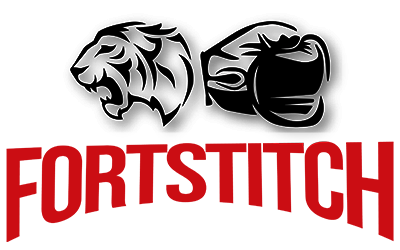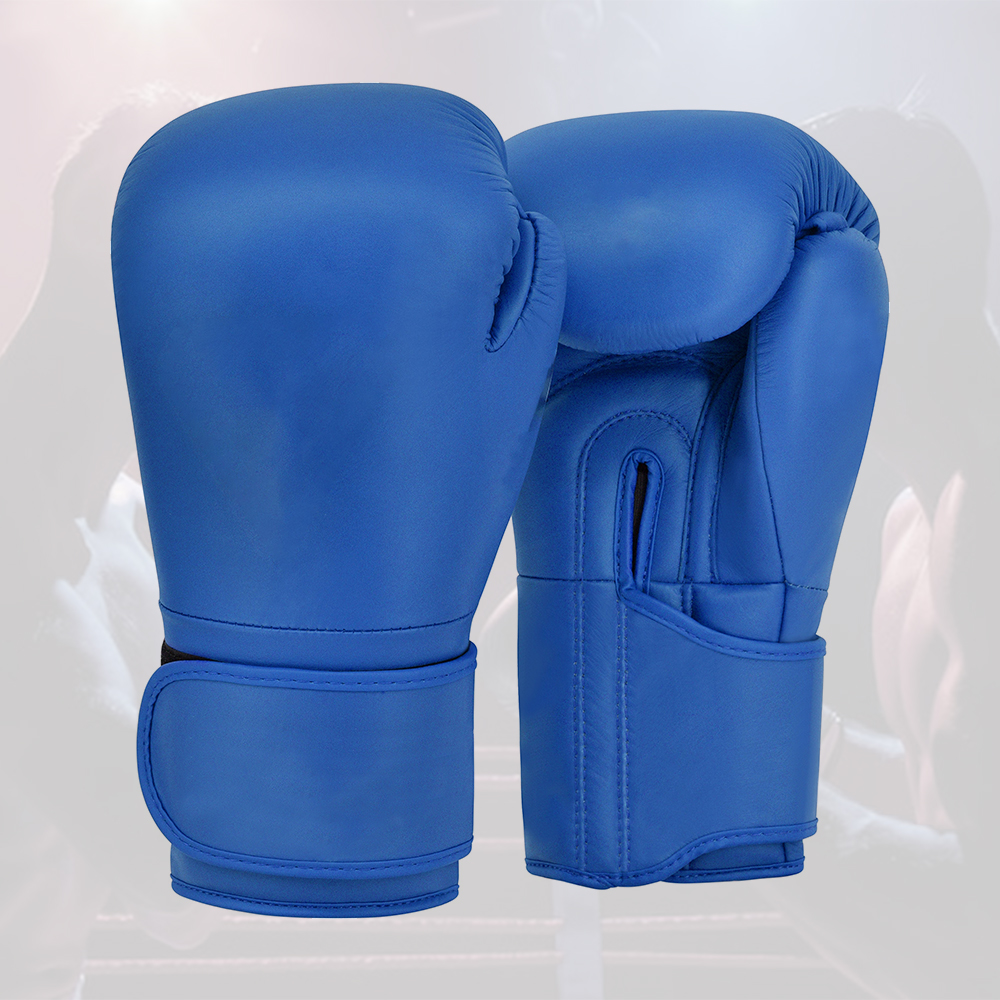Are you tired of watching others succeed in the boxing gear market while wondering how you could start your own brand? Imagine creating boxing gloves, wraps, and protective gear that fighters love while building a business that reflects your passion for combat sports. Starting your own boxing gear brand is not just a dream; it is possible, and this guide will show you exactly how to make it happen
Whether you are a fighter, trainer, or fitness enthusiast, this step-by-step guide will take you through everything from market research and product development to branding, marketing, and growing your business. By the end, you will know how to launch a trusted boxing equipment brand that athletes and gyms can rely on
Step 1: Understand Your Market
Before you spend money on gear or a website, you need to know the market inside out.
- Study the competition: Look at top brands like Everlast, Venum, Hayabusa, and smaller niche brands. Notice their prices, product features, marketing style, and customer reviews. Think about what they do well and what they miss.
- Understand your customers: Beginners often want affordable and simple gear. Professionals prioritize performance and durability. Fitness enthusiasts look for stylish gear that fits their workouts.
- Identify market gaps: Ask yourself: Are there products that are hard to find? Can you create something better, safer, or more stylish?
You can visit gyms, watch training videos, check online forums, and run surveys to understand what people want. The more you know, the better you can design products that sell and meet real needs.
Step 2: Know Who You Are Selling To
Your audience is the heart of your boxing gear brand. Understanding who you’re selling to will guide every decision, from the types of products you offer to how you price and market them.
Start by identifying your key segments:
- Beginners: People just starting boxing or fitness training who want easy-to-use, safe, and affordable gear.
- Professional fighters: Athletes who demand high-quality, durable, and performance-driven equipment
- Youth and women: Often overlooked segments with specific sizing, design, or style preferences.
- Gyms and training centers: These buyers often purchase in bulk and value consistent quality and reliability.
Next, think about what your customers want:
- Do they prioritize comfort, durability, or performance?
- Are they looking for stylish gear, or are they focused on value for money?
- Do they care about eco-friendly materials or premium finishes?
Finally, consider how your customers shop:
- Online buyers value convenience, product descriptions, and reviews.
- Gym or retail buyers like to see and try gear before purchasing.
When you clearly understand your audience, you can customize your boxing products and marketing messages to meet their needs. For instance, if you’re targeting beginners, emphasize safety, comfort, and ease of use in your product descriptions and ads. If you’re targeting professional fighters, highlight durability, performance, and advanced features.
By knowing your audience inside out, you’ll create products and promotions that truly resonate, making it easier to build a loyal customer base and grow your brand.
Step 3: Create a Strong Business Plan
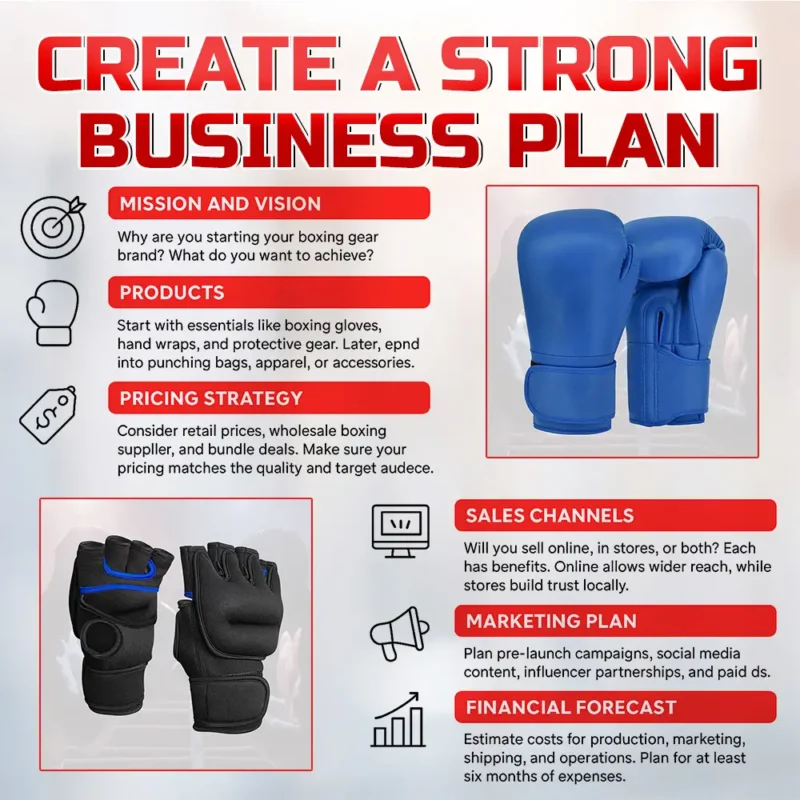
A clear business plan acts as a roadmap for your brand and helps you avoid mistakes.
Include:
- Mission and vision: Why are you starting your boxing gear brand? What do you want to achieve?
- Products: Start with essentials like boxing gloves, hand wraps, and protective gear. Later, expand into punching bags, apparel, or accessories.
- Pricing strategy: Consider retail prices, wholesale boxing supplier, and bundle deals. Make sure your pricing matches the quality and target audience.
- Sales channels: Will you sell online, in stores, or both? Each has benefits. Online allows wider reach, while stores build trust locally.
- Marketing plan: Plan pre-launch campaigns, social media content, influencer partnerships, and paid ads.
- Financial forecast: Estimate costs for production, marketing, shipping, and operations. Plan for at least six months of expenses.
A strong plan will help you stay organized, attract investors, and make confident business decisions.
Step 4: Test Your Idea and Plan Funding
Even before producing large quantities, you should validate your idea.
- Run surveys and polls: Ask your potential customers what they want in boxing gear. What size, material, or style do they prefer?
- Offer pre-orders: Launch a landing page or social media campaign where people can buy in advance. This helps measure interest.
- Start small: Produce a limited batch of products to test the market. Get feedback on design, comfort, and durability.
- Plan your funding: Use personal savings, loans, crowdfunding, or investors to finance your launch. Make sure you know exactly how much you need for production, marketing, and operations.
By testing first, you reduce risk and improve your products based on real feedback.
Step 5: Product Development and Quality
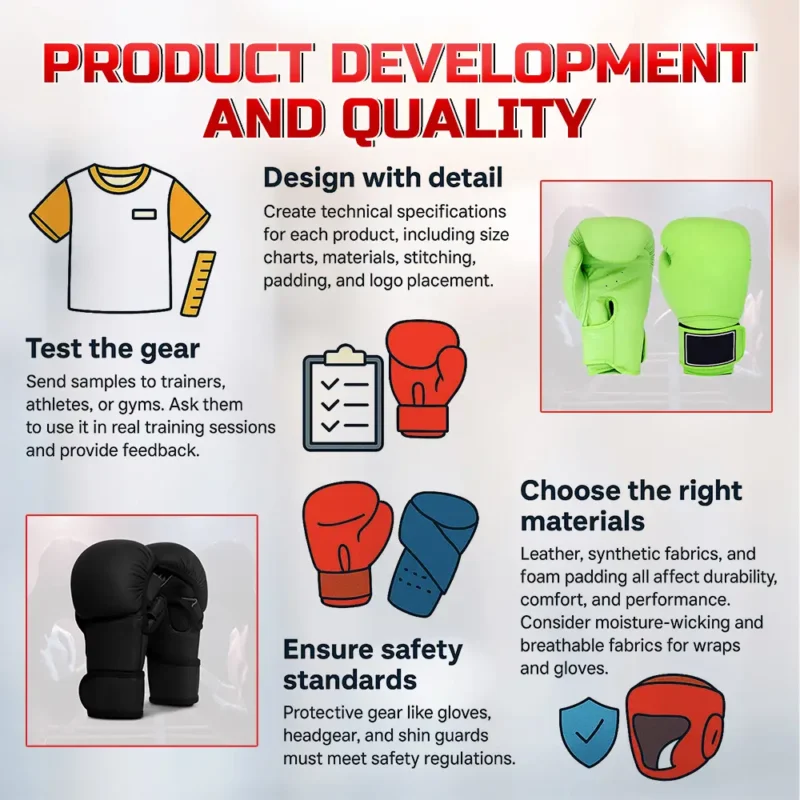
Your products are the foundation of your brand’s reputation. Good products lead to repeat customers and strong word-of-mouth.
- Design with detail: Create technical specifications for each product, including size charts, materials, stitching, padding, and logo placement.
- Test the gear: Send samples to trainers, athletes, or gyms. Ask them to use it in real training sessions and provide feedback.
- Choose the right materials: Leather, synthetic fabrics, and foam padding all affect durability, comfort, and performance. Consider moisture-wicking and breathable fabrics for wraps and gloves.
- Ensure safety standards: Protective gear like gloves, headgear, and shin guards must meet safety regulations.
High-quality, well-tested products will make your customers trust your brand and come back for more.
Step 6: Work With Reliable Suppliers
Suppliers play a critical role in your success.
- Research suppliers: Compare local and international boxing gear manufacturers, read reviews, and ask for references.
- Negotiate terms: Minimum order quantity, pricing, and delivery timelines should be agreed upon upfront.
- Manage inventory: Track stock levels to avoid shortages or overstocking.
- Plan logistics: Decide whether you will handle shipping in-house, use dropshipping, or hire a third-party logistics company.
Strong supplier relationships ensure you deliver quality products consistently and on time.
Step 7: Build Your Brand Identity
Your brand is what people remember and trust.
- Name and logo: Make them bold, memorable, and related to boxing or combat sports.
- Storytelling: Share your journey, passion, or reason for starting the brand. People love connecting with authentic stories.
- Visual style: Use consistent colors, fonts, and designs across your website, social media, and packaging.
- Unique selling point: Decide what makes your gear different, eco-friendly materials, premium quality, or affordable starter kits.
A strong brand sets you apart in a crowded market and helps customers feel connected to your business.
Step 8: Marketing Your Boxing Gear
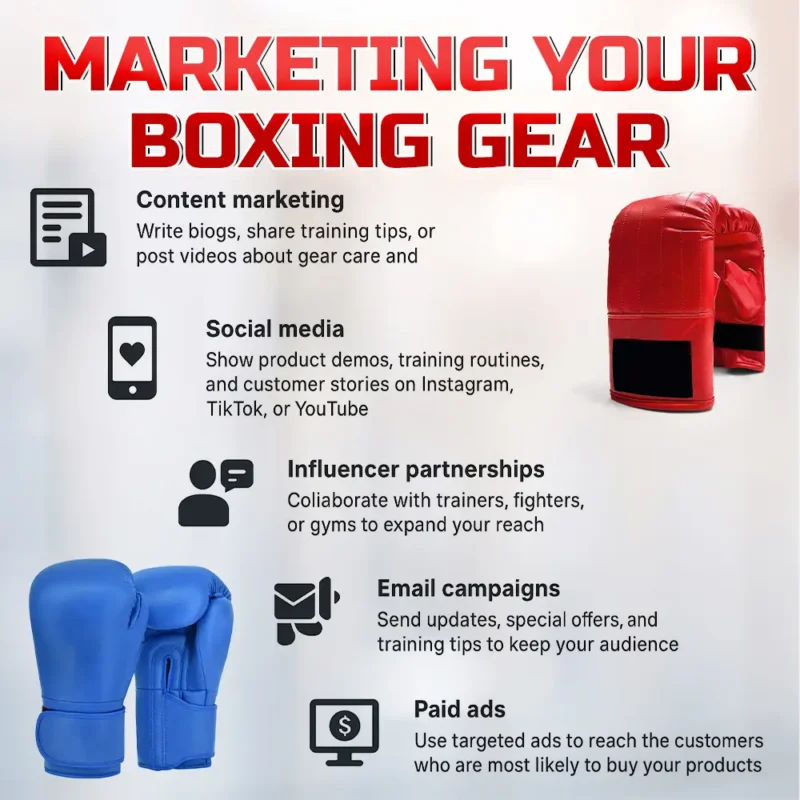
Marketing helps your brand reach the right people and build trust.
- Content marketing: Write blogs, share training tips, or post videos about gear care and workouts.
- Social media: Show product demos, training routines, and customer stories on Instagram, TikTok, or YouTube.
- Influencer partnerships: Collaborate with trainers, fighters, or gyms to expand your reach.
- Email campaigns: Send updates, special offers, and training tips to keep your audience engaged.
- Paid ads: Use targeted ads to reach the customers who are most likely to buy your products.
Your marketing strategy should educate, engage, and encourage customers to try your products.
Step 9: Choose How to Sell
Deciding where and how to sell affects your growth and brand perception.
- Direct-to-consumer: Selling on your own website gives you control and higher profit margins.
- Marketplaces: Platforms like Amazon, eBay, and niche sports stores increase visibility.
- Gyms and retail stores: Partner with gyms to sell in bulk and build local credibility.
- Launch strategy: Create excitement with early bird deals, giveaways, and promotions.
A well-planned sales strategy ensures your products reach the right audience and your brand gets noticed.
Step 10: Measure, Improve, and Scale
Even after launch, you need to keep improving your brand.
- Track metrics like sales, customer acquisition cost, returns, and website traffic.
- Gather customer feedback to improve products and service.
- Expand your product line gradually: headgear, punching bags, apparel, or accessories.
- Engage with your community: sponsor tournaments, run challenges, or collaborate with gyms.
Continuous improvement helps your brand stay relevant, grow, and build loyalty.
Step 11: Legal, Safety, and Compliance
Protect your business and customers.
- Register your business and trademark your brand.
- Ensure all products meet safety standards.
- Use contracts for suppliers, retailers, and partners.
- Consider insurance to protect against product liability.
Following the law helps you avoid problems and gain customer trust.
Step 12: Avoid Common Mistakes
Many new brands make preventable mistakes:
- Ordering too much inventory before testing demand.
- Compromising on product quality.
- Expanding too fast without understanding customers.
- Ignoring legal and safety requirements.
Careful planning and testing first will save you time, money, and reputation.
Conclusion
Starting a boxing gear brand is exciting and rewarding. By researching your market, creating high-quality products, building a strong brand, marketing effectively, and improving constantly, you can create a trusted name in combat sports.
Take it step by step, listen to your customers, and focus on quality and consistency. Your brand can inspire athletes, gyms, and fitness enthusiasts while growing into a successful business
